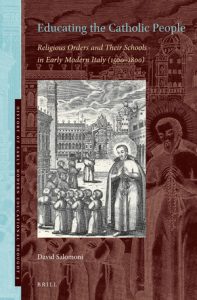 In Educating the Catholic People, David Salomoni reconstructs the complex educational landscape that arose in sixteenth-century Italy and lasted until the French Revolution. Over three centuries, various religious orders, both male and female, took on the educational needs of cities and states on the Italian peninsula, renewing the traditional humanist pedagogy. Historians, however, have not attempted to produce a synthesis on this topic, focusing mainly on the pedagogical activities of the Jesuits and neglecting the contributions and innovations of other groups. This book addresses this historiographical gap, providing a new chapter in the comparative study of pre-modern education.
In Educating the Catholic People, David Salomoni reconstructs the complex educational landscape that arose in sixteenth-century Italy and lasted until the French Revolution. Over three centuries, various religious orders, both male and female, took on the educational needs of cities and states on the Italian peninsula, renewing the traditional humanist pedagogy. Historians, however, have not attempted to produce a synthesis on this topic, focusing mainly on the pedagogical activities of the Jesuits and neglecting the contributions and innovations of other groups. This book addresses this historiographical gap, providing a new chapter in the comparative study of pre-modern education.“Religious Orders and Their Schools in Early Modern Italy (1500–1800)”, by David Salomoni
 In Educating the Catholic People, David Salomoni reconstructs the complex educational landscape that arose in sixteenth-century Italy and lasted until the French Revolution. Over three centuries, various religious orders, both male and female, took on the educational needs of cities and states on the Italian peninsula, renewing the traditional humanist pedagogy. Historians, however, have not attempted to produce a synthesis on this topic, focusing mainly on the pedagogical activities of the Jesuits and neglecting the contributions and innovations of other groups. This book addresses this historiographical gap, providing a new chapter in the comparative study of pre-modern education.
In Educating the Catholic People, David Salomoni reconstructs the complex educational landscape that arose in sixteenth-century Italy and lasted until the French Revolution. Over three centuries, various religious orders, both male and female, took on the educational needs of cities and states on the Italian peninsula, renewing the traditional humanist pedagogy. Historians, however, have not attempted to produce a synthesis on this topic, focusing mainly on the pedagogical activities of the Jesuits and neglecting the contributions and innovations of other groups. This book addresses this historiographical gap, providing a new chapter in the comparative study of pre-modern education.